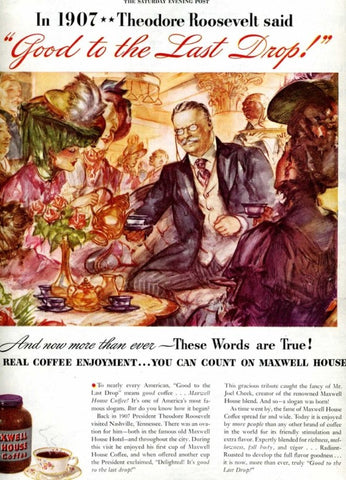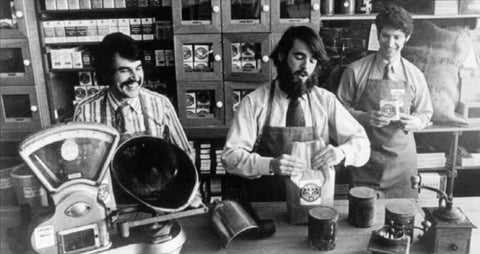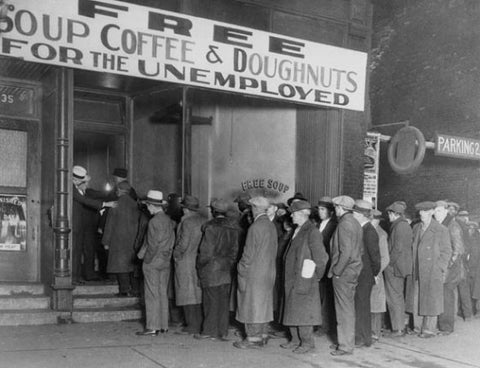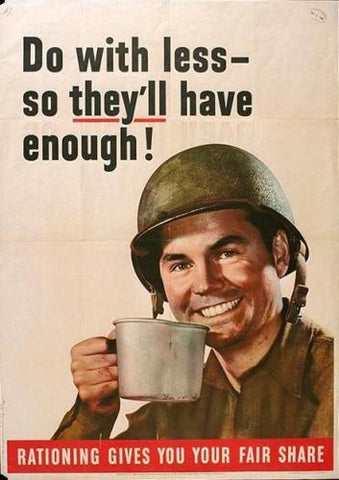The Manly History of Coffee: Part 2 – The 20th Century to Today
Aug 14, 2015

“The morning cup of coffee has an exhilaration about it which the cheering influence of the afternoon or evening cup of tea cannot be expected to reproduce.” – Oliver Wendell Holmes, Associate Justice of the U.S. Supreme Court, 1841-1935
In the first part of this series, we looked into the manly origins of coffee, which we learned was the drink of choice for presidents, statesmen, frontiersmen, cowboys, and soldiers. It has always been the beverage the gives you the get-up-and-go, even when you would rather lie in bed and contemplate your eyelids. In this next part, we will continue the story by looking at the last 100 years or so, and the role that coffee has played in our history.
Coffee in the 20th Century
By the turn of the 20th century, America had really developed an earnest taste for coffee. Coffeehouses and brands developed across the country. Better branding and distribution meant that more and more were able to partake in a fresh cup of coffee in the morning. Much of this was made possible by brands like Folger’s and Maxwell House, the latter was even given a great slogan by President Theodore Roosevelt. Upon finishing a cup of Maxwell coffee is quoted as saying it was, “Good to the last drop!” The slogan stuck, and quickly helped Maxwell House develop into one of America’s favorite brands of coffee. (See a side note on this in the pic below)
Roosevelt was no stranger to a good cup of coffee. He always started his day before dawn so he could get a jump on what lie ahead. He was known for putting copious amounts of sugar in his coffee, sometimes as much as seven lumps. Some have estimated that he drank about a gallon of coffee a day, easily made possible by his favorite mug, which he said was “more in nature of a bathtub.” Coffee didn’t put gusto in Roosevelt’s life, that coiled energy was of course always there, but it did perhaps sustain that gusto over time.

Maxwell House credits its popular slogan “Good to the last drop!” as coming from Theodore Roosevelt. However, some witnesses reported the President as saying, “This is the stuff I like to drink when I shoot bears.” which I believe would have also made it quite popular.
Coffee During the Great War
As the United States entered the fray of World War I in 1917, the need for coffee was greater than ever. Again, coffee was needed to get men motivated, marching, and mentally aware. American soldiers in Europe were consuming thousands of pounds of coffee per day. Coffee brands not only had to ramp up production, but provide a soluble coffee that would keep in the long overseas voyage to Europe, easily dissolve in sometimes lukewarm water, and still have some flavor. Simple ground coffee was often not practical, or possible, as the average coffee was about six months old by the time it hit a soldier’s lips. Still, just as in the Civil War, daily coffee was of the utmost importance, especially for young men who found themselves thousands of miles away from home for the first time, on foreign soil.
The Great Depression and Coffee
If we flash forward to the Great Depression of the 1930s, we see that coffee remained an important piece of American life. Whether unemployed, or having lost a lot of money, many were stretched so thin that they simply could not afford extras such as coffee, even at just five cents. But, by this point in time coffee was seen as an essential part of an American’s day. Soup kitchens sprang up all over America to offer some relief to the unemployed, which in addition to the soup, offered up a hunk of bread, and a hot cup of coffee.
In those tough times for out of work men, getting soup and coffee must have been like manna from heaven. A sustaining force in otherwise troubling and uncertain times. It provided men with a reason to go on, when little else did. Even ruthless mobsters like Al Capone saw the need for relief. Throughout the 1930s lines formed outside his Chicago soup kitchen, which also provided “Free cup coffee and Doughnuts.” That unique pairing started a love affair between coffee and doughnuts that continues today. At about the same time, Rudolph Vernon decided to sell the pairing in his first Krispy Kreme shop in 1937 in Winston-Salem, North Carolina. Vernon’s very first shop, which was located in Old Salem, no longer stands today, but there is a marker at its original location (in case you want to travel to the Mecca of the southern doughnut!).

16 Nov 1930, Chicago, Illinois, USA — Notorious gangster Al Capone attempts to help unemployed men with his soup kitchen “Big Al’s Kitchen for the Needy.” The kitchen provides three meals a day consisting of soup with meat, bread, coffee, and doughnuts, feeding about 3500 people daily at a cost of $300 per day.
Coffee During World War II
As we have already witnessed, coffee remains extremely important during wartime. As the nation prepared to enter World War II at the end of 1941, it did so with coffee on the mind. Coffee production was at an all-time high, but so was consumption in America. On average, right before the war, an American’s consumption of coffee reached about 20 pounds a year. It seemed that everyone wanted coffee and no one was prepared to do without. So, in 1942, the U.S. Government limited coffee roasters to 75 percent of their supply in order to ensure that soldiers overseas would get their cup of joe. It made it so that soldiers waking up in the Pacific, Europe, or Africa could have their coffee, as they fought tooth-and-nail to end the war.
By the end of 1942, coffee rationing was in full effect. Americans were now forced to make do with about half the amount of coffee they were used to. At the time, Americans could get one pound of coffee every five weeks. Many simply decided to stretch, or thin their coffee so it felt as though they were drinking the same amount. Ultimately, rationing and its watered-down cups of coffee proved to be wildly unpopular. By mid-1943, President Franklin Delano Roosevelt announced that coffee rationing would end, becoming the first rationed item to come off the list. With Americans already doing without, or fewer, of many everyday essentials, many could not do without their coffee.
Before the Allied invasion of Normandy, France on June 6, 1944, General Dwight D. Eisenhower fueled himself in the early morning under an endless stream of cups of coffee. (He was known for drinking several cups a day, as well as smoking several packs of cigarettes.) The successful invasion, known as D-Day, found men dug in just beyond the Normandy coast for a cup. This invasion signaled the beginning of the end of the war. It is not a far stretch to say that coffee helped to win the war.

During World War II coffee was a serious morale booster for soldiers. Rationing ensured soldiers got a share.
1950s and the Drip Coffee Maker
After World War II, a generation of men that had been forged in the tough circumstances of war returned to the civilian world, and went back to work. At the same time, coffee commercials hit the airwaves for the first time, and convinced many that they needed to make coffee a continued part of their morning routine. Many even touted how important it was for a woman to be able to brew a good cup of coffee. A super cut of funny (and often sexist) ads from the 50s and 60s can be seen here. Gems like, “How can such a pretty wife make such bad coffee,” are sure to give you a hearty chuckle. Apart from the more targeted ads, the electric drip coffee maker made it easier than ever to brew a cup at home. Gone were the days of fiddling with the stove-top percolator.
By the 1960s, many had grown up with the coffee brands we know today. Brands like Maxwell House and Folger’s were staples of the industry. Coffee was simply part of everyday life. Coffeehouses and diners were popular hangouts for teens and young adults. They were places to gather away from the umbra of the adult world, while sharing in a good cup of coffee, and perhaps some pie. In the 1960s, places such as Waffle House and Denny’s became institutions that people flocked to.

Coffee, hamburgers, a donut, and TWO women in the car? Not to mention the great hair! Coffee advertisement was in full effect by the 1950s.
1970s and Starbucks
Seattle roastery Starbucks pretty much single-handedly created the gourmet coffee craze in the 1970s. People at the time wanted more than a hot, black liquid to wake them up. They wanted higher quality beans; a fresher taste; more variety. We are still living in the era that Starbucks created. Many today are obsessed with taste and variety. If your grandpa were to walk into a coffee shop today the variety of options may seem ridiculous. Back in his day, there was only one option: coffee. All this has prompted some to head back to simpler times, by brewing at home — often on some nostalgic items like the stove-top percolator or a French Press. Even the original drip coffee maker still holds its own today. Things need not be overly complicated. A fresh, quality roast, brewed simply, will do the job.

Starbucks in the 1970s. Oh how far they have fallen. I mean, these guys were hipsters before it was a thing! Check out the wood coffee grinders!
Conclusion
It should be clear that coffee has always been a manly beverage and, over the years, it became America’s beverage. It has long provided men with the grit, drive, and gumption to go on, often when they didn’t want to, or the road ahead looked perilous. Men today could take a page from the way coffee used to be consumed. We need to rekindle the cup of joe that our forefathers once knew and loved. In recent years, in the quest for better flavor and variety, coffee has become overly fussy. Let’s face it, that soy, non-fat latte is not going to make you feel manly. Nor, is handing over the $4-$6 to pay for it. However, brewing a strong, bold roast at home might.
More Articles in This Series:
- The Manly History of Coffee: Part 1 - Westward to the Civil War
- The Manly History of Coffee: Part 2 - The 20th Century to Today
— Erik Hill is an Adjunct English Instructor at Davidson County Community College in North Carolina. He is an avid trail runner, whose interests revolve around history and English literature. He spends most of his days dreaming of the days of yore. —


